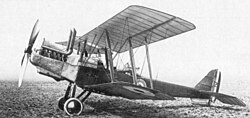Royal Aircraft Factory RE8
| Royal Aircraft Factory RE8 | |
|---|---|
 RE8 built by Siddeley-Deasy |
|
| Type: | bomber |
| Design country: | |
| Manufacturer: | |
| First flight: |
1916 |
| Commissioning: |
1916 |
| Number of pieces: |
4077 |
The Royal Aircraft Factory RE8 was a two-seat British biplane - bombers in World War I . The crews of these planes called them "Harry Tate".
History and construction
The RE8 was supposed to replace the easily vulnerable BE2 . Although the RE8 was an advance on the BE2, it was considered one of the worst aircraft models in World War I. A total of 4099 RE8 were built from 1916. The main areas of use were in Italy , Russia , Palestine and Mesopotamia .
Development work began in 1915; the first of the two prototypes of the RE8 flew for the first time on June 17, 1916 and was also subjected to field testing in France. Series production began in August 1916, and the first series machines came to France in November 1916. The machines were so unstable that many went into a tailspin and caused a series of fatal accidents. Even after the tail unit was extended, many instabilities remained. T. structural strength problems. The RE8 was produced by six companies in addition to the Royal Aircraft Factory ; these were z. B. Austin Motors , Standard Motors , Siddeley-Deasy, and Coventry Ordnance Works.
The RE8 was built larger and more stable than the BE2 and was armed with a synchronized forward-firing 7.7 mm Lewis machine gun and one or two Lewis machine guns with a turntable in the observer position. As with the BE2, enemy artillery positions could also be cleared up with the RE8, but it was easy to outmaneuver by enemy fighters. The fuel tank had the ability to catch fire quickly when hit. On April 13, 1917, six RE8s hit a Jasta 11 aircraft - all of which were shot down within five minutes.
Most RE8 had 150 hp (112 kW) powering 12-cylinder in-line engines Royal Aircraft Factory 4a, which were later replaced by 200 hp (149 kW) RAF 4d engines. Some machines were also equipped with Hispano-Suiza engines. The engine exhaust gases were passed through two long exhaust pipes over the upper wing.
The RE8 was used in 18 squadrons in 1917 and in 19 squadrons of the Royal Flying Corps in 1918. Belgium was the only other country to use 22 RE8 machines from July 22, 1917. The RE8 was used as a reconnaissance aircraft, night bomber and attack aircraft.
After the First World War, the RE8 was retired very quickly. Today there are only two machines left. The restoration of the RE8 F3556 at the Imperial War Museum Duxford was completed in 2004. Another RE8 exists today in Brussels , Belgium .
Military use
Technical specifications
| Parameter | Data |
|---|---|
| crew | 2 (pilot and observer) |
| length | 8.48 m |
| Wingspan | 12.98 m |
| height | 3.45 m |
| Wing area | 35.07 m² |
| Empty mass | 818 kg |
| Takeoff mass | 1302 kg |
| drive | 1 × air-cooled 12-cylinder in-line engine Royal Aircraft Factory 4a , 112 kW (approx. 150 PS) |
| Top speed | 164 km / h in 1981 m |
| Ascent time to 3000 m | 39 min |
| practical summit height | 4115 m |
| Flight duration | 4:15 h |
| Armament | Max. 3 MG 7.7 mm, max. 102 kg bombs (2 × 51 kg) |
literature
- Bruce, JM (1957). British Airplanes 1914-18. London: Putnam.
- Bruce, JM (1992). The Airplanes of the Royal Flying Corps (Second ed.). London: Putnam. ISBN 0-85177-854-2 .
- Lewis, Peter (1974). The British Bomber since 1914 (Second ed.). London: Putnam. ISBN 0-370-10040-9 .
- Taylor, Michael JH (1989). Jane's Encyclopedia of Aviation. London: Studio Editions.
- The Illustrated Encyclopedia of Aircraft (Part Work 1982-1985). Orbis Publishing. p. 2820.
